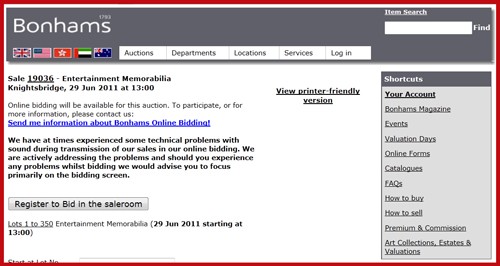The second of two Entertainment Memorabilia auctions to be held by Bonhams in the month of June has published its catalog online. This event will be held at their Knightsbridge location in England on June 29th for their “Entertainment Memorabilia” auction (Sale 19036). The first auction will be held in Los Angeles on June 29th.
The online auction catalog for the auction in England can be viewed at Bonhams.com:
This sale includes 350 lots. Though much of the auction is comprised of Hollywood and celebrity-owned memorabilia and personal property, photographs, stills, posters/one sheets, and general “entertainment memorabilia”, there is a good selection of original props and costumes as well. Also included in the auction are letters, contracts, scripts, caricatures, paper ephemera, paintings, prints, industry awards, and other memorabilia and movie and television production material and assets.
This sale also includes a substantive selection of music/rock/pop-related memorabilia.
The highlight of the sale is a rare Charlie Chaplin film from 1916 (see Lot 350):
Charlie Chaplin: A rare and unique film entitled ‘Zepped’, 1916
Over six minutes long, this film is believed to be the sole surviving copy of the short film ‘Zepped’, Essanay Film Co., on 35mm nitrate stock film, approximately 500 – 600ft in length, in original tin, the opening sequence stating ‘Charlie Chaplin In Zepped, Essanay Film Co.’, with Ministry of Interior film censorship certificate ‘Passed for Exhibition in Egypt’, featuring previously unknown Chaplin composition, weight 1lb 8oz (original footage states weight 3lb 2oz, discrepancy due to original metal spool being removed and length 800ft on 2nd October 1917)
Footnote:
“Zepped” was discovered by the vendor in September 2009 and is a previously unrecorded Charlie Chaplin short film, one of only two unrecorded films to have been discovered in recent decades.
First exhibited on the 23rd December 1916, and made in October/ November 1916, “Zepped” was created from unknown /unseen outtakes of four earlier Chaplin films, His New Profession (1914), A Jitney Elopement (1915), By The Sea (1915) and The Tramp (1915) (made by two different studios, Essanay and the Keystone Company) as well as newsreel footage and animation. The film also implements important cinematographic techniques including some of the earliest examples of stop-motion animation, a pioneering method of painting or scratching directly on the film to create the special effects of bomb explosions, and believed to be images of a real Zeppelin (if so being the only recorded period film of a Zeppelin attack).
The film itself was exhibited during 1916 and research undertaken by the vendor revealled an advertisement in the Manchester Film Renter for a trade viewing of the film at Victoria Street, Manchester, in 1917. The Film Renter states: a new Chaplin comedy entitled “Zepped” and tells the trade “not to miss the opportunity of seeing and securing this original and sure-to-be popular comedy”. This advertisment is the only evidence of public viewing known to have survived. The film itself reveals it was issued with an Censors certificate for exhibition in Egypt, it is believed it was issued as a morale boosting film to troops stationed in Egypt during World War I. However, the subject matter of Zeppelin attack may have been deemed unsuitable for wider audiences. The last known reference to the film is contained within the British Board of Film Censorship’s Ledgers, when it was examined, measured and passed “For Export Only”, this record is dated October 1917.
The extreme shift in warfare during World War I (1914-1918), exemplified by rapid technological advancements, the related retirement of defunct tactics, and the increased awareness of civilian populations, both in physical involvement and media coverage, was a turning point in the wars of the twentieth century. Germany’s use of Zeppelins, operated by the army and navy in two separate divisions, had two main objectives; reconnaissance and bombing missions. Although the casualties caused by Zeppelin bombing raids over Britain were relatively small, and the reconnaissance operations, to some degree, had a larger impact during the conflict, it was the raids that truly captivated the public’s imagination.
The psychological effect of the missions was monumental, creating an aura of fear akin to previous historical threats of land invasion, but amplified owing to the destruction delivered directly into areas of civilian population. The aura of fear was to some extent justifiable as the Zeppelin flights were the first time that Britain had experienced great conflicts which directly involved civilians and civilian populated areas. The propaganda campaign initiated in response to the attacks was monumental, passing the ‘Baby Killers’ nickname for Zeppelins into common parlance, as well utilising the fear and anger at the attacks on civilians as recruiting drives for the military. The lives of British civilians were lived under the auspice of omnipresent potential attacks relating directly to the Zeppelins.
Charlie Chaplin’s involvement in World War I is well documented, from the furore over his lack of service to his involvement in addressing the issues of the conflict through film Shoulder Arms (1918), a position he revisited throughout his career, perhaps best seen in his film The Great Dictator (1940) released during World War II. Zepped is a zeitgeist of the period, where Zeppelin usage was regularly discussed and even lampooned, indeed, the magazine Punch was full of Zeppelin jokes. The current form of Zepped, although entailing six minutes of a film, is hugely important in the history of cinema.
Jason DeBord


